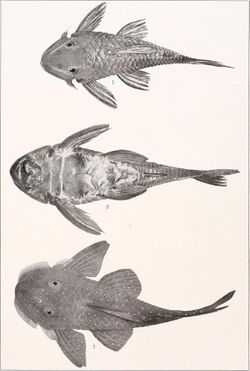Biology:Corymbophanes
| Corymbophanes | |
|---|---|

| |
| C. andersoni | |
| Scientific classification | |
| Domain: | Eukaryota |
| Kingdom: | Animalia |
| Phylum: | Chordata |
| Class: | Actinopterygii |
| Order: | Siluriformes |
| Family: | Loricariidae |
| Tribe: | Ancistrini |
| Genus: | Corymbophanes C. H. Eigenmann, 1909 |
| Type species | |
| Corymbophanes andersoni Eigenmann, 1909
| |
Corymbophanes is a genus of armored catfish native to South America where they are only known from Guyana. Corymbophanes was originally placed in its own tribe Corymbophanini, but the first comprehensive molecular phylogenetic analysis of the subfamily Hypostominae found Corymbophanes to be nested within the tribe Ancistrini.[1]
Taxonomy
Corymbophanes and its type species, C. andersoni, were first described in 1909 by Carl H. Eigenmann.[2] In 2000, they were redescribed along with the description of a new species, C. kaiei.[3] In 2004, the tribe Corymbophanini was erected.[4]
Corymbophanes represents an old lineage as it lacks many of the characteristics of the rest of the subfamily Hypostominae. This group probably has a basal position within the subfamily.[3]
Species
There were previously two recognized species in this genus.[5] A third species was described in a 2020 study.[6]
- Corymbophanes ameliae Lujan, Armbruster, Werneke, Teixeira & Lovejoy, 2020[6]
- Corymbophanes andersoni C. H. Eigenmann, 1909
- Corymbophanes kaiei Armbruster & Sabaj Pérez, 2000
Distribution and habitat
Corymbophanes species originate from the upper Potaro River of the Essequibo River drainage system. C. andersoni is only known from the Chenapou Falls of this river. C. kaiei is only known from the Oung Creek, a small tributary of the Potaro River drainage. Neither of these species are found downstream of the Kaieteur Falls.[3] Corymbophanes species live in swift riffles over gravel and cobble and among submerged logs.[3]
Appearance and anatomy
Like other Loricariids, Corymbophanes species have plates of armor on their body and a suckermouth. Small odontodes are also present along their body.[3] This genus can be distinguished from all other Loricariids by the presences of a dorsal ridge formed by plates between the dorsal fin and the caudal fin, the absence of the adipose fin, as well as the absence of the omega iris that most loricariids possess.[3] Corymbophanes species do not have evertible cheek plates and do not hypertrophied cheek odontodes which are present in many other loricariid species, which differentiates it from the few species that possess the aforementioned ridge.[4]
Species of this genus do not get very large; C. andersoni does not exceed 8.6 centimetres (3.4 in) and C. kaiei does not exceed 6.6 cm (2.6 in).[2][7] These fish are dark brown to black with white or cream-colored markings.[3] C. kaiei has alternating light and dark bands on its caudal fin; also, this species has a dark-colored abdomen with light vermiculations in adults. By contrast, C. andersoni has no bands on the caudal fin, has no vermiculations, and the abdomen is light-colored.[3]
References
- ↑ Lujan, N. K.; Armbruster, J.W.; Lovejoy, N. R.; López-Fernández, H. (2015). "Multilocus molecular phylogeny of the suckermouth armored catfishes (Siluriformes: Loricariidae) with a focus on subfamily Hypostominae". Molecular Phylogenetics and Evolution 82 Pt A: 269–88. doi:10.1016/j.ympev.2014.08.020. PMID 25193609.
- ↑ 2.0 2.1 Froese, Rainer and Pauly, Daniel, eds. (2007). "Corymbophanes andersoni" in FishBase. May 2007 version.
- ↑ 3.0 3.1 3.2 3.3 3.4 3.5 3.6 3.7 Armbruster, Jonathan W.; Sabaj, Mark H.; Hardman, Michael; Page, Lawrence M.; Knouft, Jason H. (2000). Schaefer, S. A.. ed. "Catfish Genus Corymbophanes (Loricariidae: Hypostominae) with Description of One New Species: Corymbophanes kaiei". Copeia 2000 (4): 997–1006. doi:10.1643/0045-8511(2000)000[0997:CGCLHW2.0.CO;2]. http://www.bioone.org/archive/0045-8511/2000/4/pdf/i0045-8511-2000-4-997.pdf.
- ↑ 4.0 4.1 Armbruster, Jonathan W.. "Corymbophanes". http://www.auburn.edu/academic/science_math/res_area/loricariid/fish_key/Corymb/corymb.html. Retrieved 2007-05-06.
- ↑ Froese, Rainer and Pauly, Daniel, eds. (2011). Species of Corymbophanes in FishBase. December 2011 version.
- ↑ 6.0 6.1 Nathan K. Lujan; Jonathan W. Armbruster; David C. Werneke; Túlio Franco Teixeira; Nathan R. Lovejoy (2020). "Phylogeny and biogeography of the Brazilian–Guiana Shield endemic Corymbophanes clade of armoured catfishes (Loricariidae)". Zoological Journal of the Linnean Society 188 (4): 1213–1235. doi:10.1093/zoolinnean/zlz090.
- ↑ Froese, Rainer and Pauly, Daniel, eds. (2007). "Corymbophanes kaiei" in FishBase. May 2007 version.
Wikidata ☰ Q3766095 entry
 |

